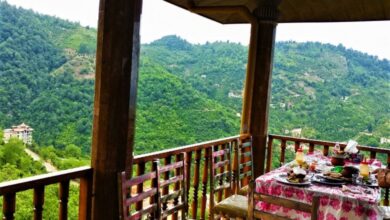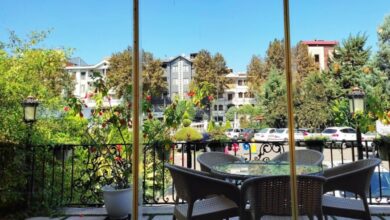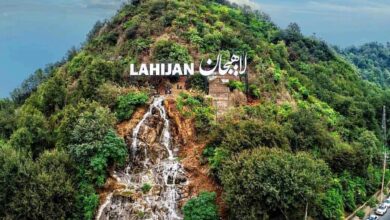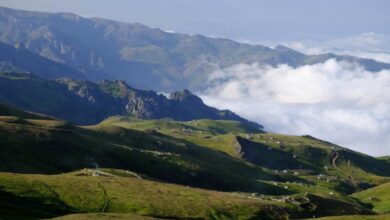Masouleh Travel Guide: Top Sights & Tips + Photos
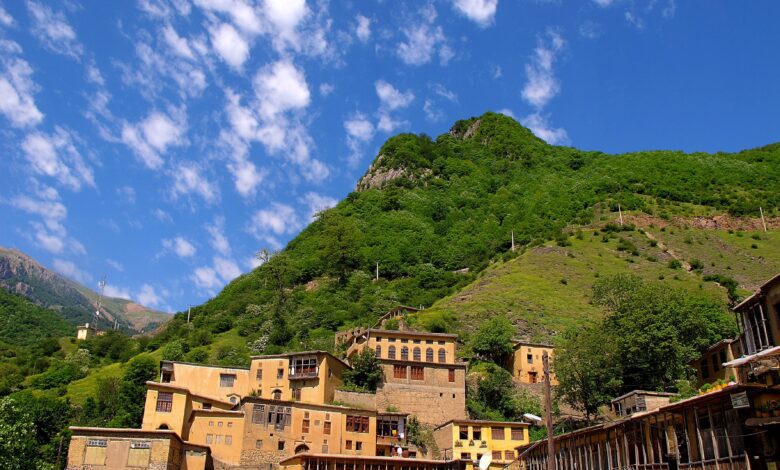
Welcome to Masouleh Village, a picturesque mountain village located in the northern province of Gilan in Iran. This Masouleh Travel Guide will help you explore a unique village that is built on the steep side of a mountain and has an architecture that is unlike any other village in Iran. The houses in Masouleh are made of clay and stone and are built on top of each other in such a way that the roof of one house is the courtyard of the house above it. This creates a unique and charming atmosphere that attracts visitors from all over the world.
The best time to visit Masouleh is during the spring and summer months, from April to September, when the weather is mild and the countryside is green and lush. According to our Masouleh Travel Guide, the village can get quite crowded during the summer months, especially on weekends, so it’s best to plan your visit during the weekdays if possible.
During the winter months, from December to February, Masouleh is covered in snow, and the village takes on a magical and serene atmosphere. The temperatures can drop below freezing, so make sure to pack warm clothing and appropriate footwear if you’re planning to visit during the winter. Our Masouleh Travel Guide suggests checking weather conditions before your trip.
Contents
Where is Masouleh?
This Masouleh Travel Guide will cover everything you need to know about exploring this enchanting destination.
Masouleh is located in a mountainous region in the southern part of Gilan province, amidst dense forests. The distance from the center of Masouleh to the border of Zanjan province is about 2 kilometers, and to the Gilavan area in Ardabil province is about 10 kilometers.

In general, there are two routes to travel to Masouleh. The Fuman-Masouleh road from Gilan province and the Majalan-Masouleh road from Ardabil province. Majalan is the last village in Ardabil province on the way from Khalkhal to Masouleh.
The road that leads to Masouleh from the village of Majalan used to be an old route for caravans or pedestrians, which later became passable for vehicles with the development of villages along the route and road construction.
In recent years, this road has received attention and at the time of writing this article, the asphalt and safety improvement project of the Majalan-Masouleh road is nearing completion. Some parts of the road are still unpaved.
The old access road to Masouleh is the same Fuman road, which is open all year round.
The closest route to reach Masouleh from Tehran is the Qazvin-Rasht road to the Saravan region, and then continuing on the Saravan-Fuman road.
Road distances from Masouleh to surrounding cities:
- Rasht: 55 kilometers
- Fuman: 32 kilometers
- Maklavan: 20 kilometers
- Tarom: 100 kilometers
- Zanjan: 170 kilometers
- Tehran: 380 kilometers
What type of trips are suitable for Masouleh?
Most of us Iranians have a preference for a specific kind of trip; a group or family trip with a personal car, having lunch at the destination, and then returning to the place of residence. However, not everyone is fond of this kind of journey, and often a one-day trip is not enough for attractive destinations.
We suggest considering other types of trips for planning visits to the attractions of Masouleh, such as:
- Staying for several days and touring all the attractions in Masouleh.
- Mountain climbing and ascending to the peaks.
- Visiting Masouleh and then traveling to Zanjan or Ardabil.
- Participating in festivals or religious ceremonies.
There isn’t a specific calendar regarding the festivals, and typically the tour organizers of Masouleh announce them in advance.
The “Alam-bandan” ceremony of Masouleh, which is held during Muharram, is famous. Many photographers travel to Masouleh to capture images of this magnificent ceremony.

Continuation on other types of trips: Our guide will further help you make a more informed decision.
Climate of Masouleh
The climate of Masouleh, like most areas in Gilan, is moderate, with warm summers and cold winters. The temperature in the summer reaches up to about 30 degrees Celsius, while in winter it can drop to around freezing.
Foggy weather is observed in Masouleh during the spring, autumn, and winter seasons. Its winters are snowy and icy.

If you are planning an adventurous trip, be aware that the weather in Masouleh is not always favorable. If you are traveling to Masouleh in the winter and fall, have tire chains for slippery roads and wear appropriate shoes.
During the midsummer days, the weather is warm, and the sky displays its cloudless blue hue.

How was Masouleh formed and why is it important?
In many mountainous regions of Iran, there are villages built in a terraced style, but among them, only a few like Masouleh have gained fame. This popularity has made the income of its residents dependent on tourism.
As recorded in history, about a thousand years ago, in an area now referred to as “Old Masouleh,” there was a marketplace for buying and selling agricultural products, metal goods, leather, winter provisions, and anything else produced by the people living on the northern and southern sides of the mountain.
In that era, the path from Fuman to Zanjan was a vital and significant route. It appears that during the winters of that period, this route was superior to other paths. Keep in mind that roads, like the one from Asalem to Khalkhal, did not exist back then, and even now, without consistent snow removal, they can easily close within hours of snowfall.
The proximity of Rudkhan Castle to this area also signifies the strategic importance of the routes in this region.
This trade and the passage of caravans over time prompted some to settle in Old Masouleh, establishing it as a center for commodity exchange. This commercial prosperity continued to the point where caravanserais were built along the route.
About 400 to 500 years ago, due to an unknown incident, residents of Old Masouleh abandoned it and built the new Masouleh about 10 kilometers away. Some say the spread of the plague caused this migration, while others believe earthquakes or local wars were the primary reason.
Extensive excavations in the land of Old Masouleh or Ancient Masouleh have revealed the existence of houses in the area, activities of blacksmithing, and signs of vibrant life. Now, all that remains of that land are scattered stones.
In the new Masouleh, the presence and demise of Imamzadeh Aoun turned it into a significant pilgrimage site for surrounding villages.
All these factors, along with abundant freshwater springs and green pastures suitable for livestock, have contributed to Masouleh’s significance.
Now, let’s explore the attractions of the new Masouleh, also known as the fog-covered paradise.

Sightseeing in Masouleh
The houses of Masouleh and their architectural style are the most attractive part of Masouleh. Traditional houses, wooden windows, and beautifully placed vases and candlesticks in the porches are unique to Masouleh’s charm.
To introduce other tourist attractions, we will start with Masouleh itself and then introduce the surrounding sights one by one.
Masouleh Bazaar

Unlike large and extended bazaars where you’d walk among shops for hours, here there are a few shops, street vendors, coffeehouses, eateries, and workshops remaining from Masouleh’s golden era.
Most of the shops sell handicrafts, souvenirs, copper and brassware, spices, pickles, and snacks.
There used to be a caravanserai here, and its bazaar was a trading hub for merchants. Caravans from the Azerbaijan region would travel to Gilan and vice versa, passing through Masouleh. For this reason, Masouleh had become a commercial center between the two regions.
From the beginning to the end of the Masouleh Bazaar, various delicious scents compel travelers to stop. The aroma of kebabs, cooked broad beans, Reshteh soup, yogurt soup, and a hint of hookah – although it’s not recommended.
The most beautiful shops in the Masouleh Bazaar are those selling woolen dolls and hand-woven Kilim bags. Many, even without any intention to buy, stroll through the busy bazaar just to admire these beauties.
If you want to take photos in local attire, at the top of the bazaar, there are local women’s and men’s clothes available for rent.
Museums of Masouleh
If you have read old guides related to the attractions of Masouleh, they would have introduced the Ethnology Museum of Masouleh. However, currently, this private museum has been closed. Instead, three other small museums are active.
The Wildlife Museum, the Museum adjacent to the Shrine, and the Cultural Heritage Museum are the three active museums in Masouleh.
The Wildlife Museum is a collection of taxidermied animals that inhabit the surrounding areas. The Wildlife Museum is located next to the bazaar.

Cultural Heritage Museum is a historical house where artifacts from the Qajar era have been collected. If you can’t find the museum, ask the locals where the “Kesheh Sar” neighborhood is; they will guide you. The museum isn’t very large, but it’s worth a visit.
The Imamzadeh Museum features a collection of ancient gravestones, the old shrine of the Imamzadeh, books, and artifacts from the Timurid and Safavid periods. While visiting the Imamzadeh, you can also take a quick tour of the museum.

Visiting all three museums doesn’t take much time; allocate about an hour in total for them.
Shrine of Imamzadeh Awn bin Ali
The shrine of Awn bin Ali, a descendant of Imam Ali, holds a significant place among the people. This shrine is located next to the main mosque of Masouleh. Most religious ceremonies, such as the Alam Bandan ritual during the month of Muharram, are performed in this mosque.

This mausoleum has been renovated several times. The details and date of a major renovation that took place during the reign of Fath-Ali Shah are inscribed on a plaque inside the mausoleum. In past years, a metallic shrine was installed to replace the old wooden one.
Masouleh River
The River of Masouleh originates from the high mountains, from the upper springs and melting snows. The river passes through Masouleh and continues its course alongside the Masouleh road, eventually watering the rice paddies.
Tall walls have been built inside Masouleh alongside the river to prevent floods from entering the town.
Tourist Attractions Around Masouleh
After touring inside Masouleh, one can explore the natural attractions surrounding the village. To roam around these tourist spots, one should be prepared for hiking on mountain slopes and, in some cases, mountaineering.
Don’t forget to wear good shoes and appropriate clothing.
Waterfalls of Masouleh
The mountainous regions of Gilan are filled with springs, rivers, and streams. Thus, one can expect to find both small and large waterfalls.
Near Masouleh, there are two relatively small waterfalls. Below, you’ll get acquainted with these waterfalls and their locations.
Masouleh River Waterfall
As the name suggests, this waterfall is located on the Masouleh River, which we introduced earlier. The waterfall is situated to the west of Masouleh, at the beginning of the Majelan road. If you follow the river’s course against the water’s flow, after a short walk, you’ll reach the waterfall.
If you’re traveling by private car, the waterfall is near Masouleh’s parking area.
Trishom Waterfall
Trishom waterfall is located on the same path that climbers take to ascend to Trishom peak.
To get there, before reaching Masouleh from the Fuman road, take a side road towards the waterfall. After the Ashklet junction, with about an hour and a half of walking, you’ll reach the waterfall. Since the waterfall isn’t marked on maps like Google Maps, it’s advisable to seek assistance from local guides.
Shah Moalem Peak or Masouleh Mountain
Shah Moalem Peak, with an elevation of 3,058 meters, is one of the few peaks above 3,000 meters in Gilan province. Many climbers choose this peak for ascent throughout the year because of its beautiful and untouched path and surroundings.

According to the tales of the indigenous people from the distant past, a hermit lived on the slopes of this mountain whose title was “Teacher”. He had willed to be buried at the highest point of this mountain, and after his death, the people did just that. However, the authenticity of these tales is unclear.
The term “Masouleh Dagi” is derived from the word “Dagh”, meaning mountain in Azerbaijani, and it means the mountain of Masouleh.
The direct distance from Shah Moallem peak to Masouleh is about 10 kilometers. Most climbers who want to enjoy the scenic beauty of the path and are not looking for mountaineering challenges take the straight-line route, which has a beautiful view from the north and south to Shah Moallem. To ascend from this route, you should go to the old area of Masouleh which is on the way to Majelan and then follow the subsidiary route towards Shah Moallem.
Trishoom Peak

Another peak, which has an elevation of 2,470 meters and is of interest to climbers, is Trishoom. To ascend to Trishoom, take the road from Fooman to Masouleh to “Zoodl Village” and then cover the approximately 10-kilometer route to the peak.
Lalandiz
This lesser-known meadow is located to the east of Masouleh. It does not have a motorable road, and there’s only one footpath through the forest, which due to frequent use has lost its vegetation cover.

With the help of local guides and a roughly 2-hour hike, you can reach this mountainous area. Please note that there are no amenities or accommodations available, only a spring in Lalandis.
Shepherds bring their flocks of sheep from the surrounding villages to Lalandis. The picturesque scenery, accompanied by the sound of the sheep’s bells, creates a uniquely serene atmosphere.
Conclusion
In conclusion, Masouleh is a gem of Gilan; a miniature masterpiece of the beauty of the four seasons of Gilan. What is less emphasized among the guides to the attractions of Masouleh is the people of Masouleh. They are Talysh-speaking people who have been welcoming guests from the past to the present and have never complained about the hustle and bustle of tourists.
